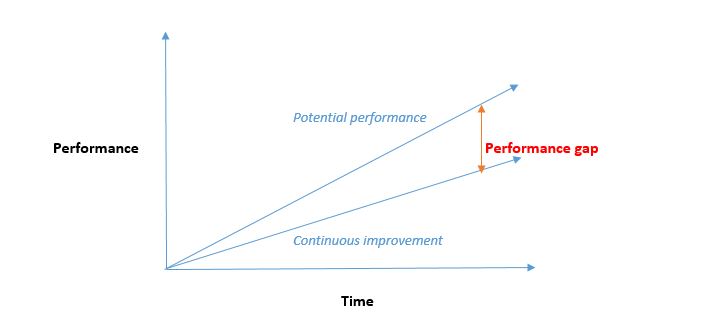The first step for improving performance: mind the gap!
As all businesses are in a continuous search for improving their organizational processes, one of the main actions that needs to be taken for seeing quality improvements and achieving a superior level of performance is closing the gaps. Improvement refers to the process through which performance gaps are actually closed, so that a company is able to achieve the desired results. The aspect that can always be improved is performance. Therefore, improvement is not a results issue, but a performance related one.
Benchmarking represents a key strategic tool used to support significant business improvements, due to its methodological uniqueness which identifies the exact processes that lead to a superior performance, as well as due to analyzing the facts behind that success.
For closing performance gaps, one must consider the following initiatives:
- Conducting a data analysis;
- Determining critical success factors;
- Using specific tools;
- Setting future goals.
- Through benchmarking data analysis, performance gaps are identified, so that organizations can immediately set up a plan for closing performance gaps and monitoring the progress. However, performance gaps need to be defined, in order to achieve the desired results. This means that an organization should focus on defining and taking the required actions in order to close current gaps between the existing activities and the initiatives that should be in place in order to be able to achieve the desired results.
On the one hand, the results a company wants to achieve are not so difficult to determine. But on the other hand, one may face challenges when seeking to identify the critical performance factors, which represent the factors that produce the identified results.
- Hence, in order to ensure an improvement, the critical performance factors have to be identified, as well as the linkage between them and the performance results. This is the reason why performance review is conducted at two different levels. Moreover, the desired results have to be stated, in order to enable their achievement. The current results have to be identified and further projected into the future so that they can be achievable.
- When it comes to the tools one can use for closing performance gaps strategic initiatives can be considered. The task for closing performance gaps is usually delegated to the leader, who should first initiate the “mapping” of the gap.
Analytics represents the main tool when referring to organizational strategic processes, so many companies delegate this responsibility for analytics to their strategic initiative groups. Also, the leader should have an understanding of competitive advantage and how this can be achieved through “big data” and analytics tools.
Moreover, it is useful to discuss gaps for formulating future strategies through visual illustrations. These type of graphics can look like the one below:
As seen above in this simple example of a performance gap, the “X axis” represents the time and the “Y axis” represents the organizational performance. Besides this, one of the trend lines shows the potential performance or the expectations regarding a certain level of performance, whereas the other is related to a forecast of what will happen if nothing changes in the process. The performance gap represents the difference between the current performance state and the desired performance state.
- As the performance gap can be quantified, in order to easily identify the relevant metrics, the strategy leaders will have to look at the “visibility” of the gap and set up future goals. Moreover, in order to have a “big picture” and complete understanding of the ongoing projects and initiatives, one of the secrets is to identify performance gaps one at a time and propose a strategic initiative afterwards. The activities that relate to the performance gap need to become the organization’s “critical path” on the road to performance improvement and should also become a top priority.
References
- Githens, G. (2012), The purpose of a strategic initiative is closing a performance gap, Leading Strategic Initiatives
- Oechsli, M. (2006), Closing Performance Gaps, Wealth Management
Image source

Tags: Benchmarking, Performance Management







